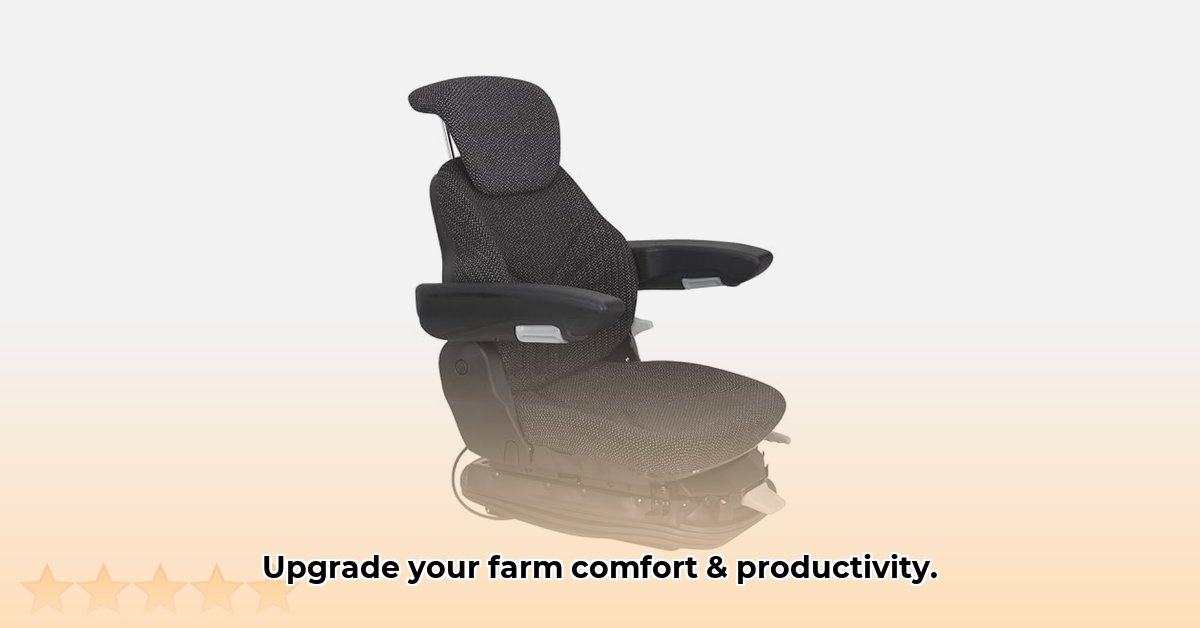
Long days in the field take a toll. Backaches, fatigue, and even injuries impact productivity and profitability. Air suspension seats offer a solution, significantly improving operator comfort and potentially boosting your bottom line. This guide explores the benefits, selection process, installation, and long-term value of these innovative seats. For more on seat cushions, see this helpful resource: additional seat comfort.
Understanding the Benefits of Air Suspension Seats
Air suspension seats utilize air bladders to cushion the operator against bumps and vibrations, dramatically reducing fatigue and discomfort. This translates to numerous advantages:
- Increased Productivity: Reduced fatigue means longer, more efficient workdays.
- Improved Focus and Safety: Enhanced alertness minimizes errors and accidents.
- Enhanced Comfort: A more enjoyable work experience is a significant benefit in itself.
Choosing the Right Air Suspension Seat
Selecting the perfect seat requires careful consideration of several factors:
- Compatibility: Ensure the seat is compatible with your tractor model. Check manufacturer specifications meticulously.
- Budget: Air suspension seats vary significantly in price. Establish a realistic budget beforehand.
- Features: Consider features like lumbar support, heating, and cooling based on your needs and climate.
- Reputation: Opt for reputable manufacturers known for quality and customer support (e.g., Concentric, Grammer, KAB, Milsco, Pilot, Sears).
Installation and Maintenance: A Step-by-Step Guide
Installing an air suspension seat is usually straightforward but requires careful attention to detail:
- Preparation: Thoroughly review the manufacturer's installation manual.
- Gather Tools: Ensure you have all necessary tools.
- Installation: Follow the manufacturer's instructions precisely.
- Testing: After installation, test all functions and adjust settings as needed.
Regular maintenance involves occasional checks of air pressure to ensure optimal performance and longevity. Always refer to the manufacturer's guidelines for specific maintenance procedures.
Weighing the Pros and Cons
While the benefits are significant, it’s crucial to understand potential drawbacks:
| Feature | Advantages | Disadvantages |
|---|---|---|
| Cost | Significantly improved comfort and productivity | Higher initial investment than standard seats |
| Maintenance | Relatively low maintenance requirements | Requires occasional air pressure checks |
| Reliability | Generally reliable and durable | Air bladder failure is possible, though rare |
Calculating the Return on Investment (ROI)
The initial cost may seem high, but the long-term ROI is substantial. While precise figures require individual data analysis, consider these factors:
- Increased Productivity: Quantify the increased acreage covered or livestock managed per day due to reduced fatigue.
- Reduced Healthcare Costs: Calculate the potential savings from fewer work-related injuries.
- Lower Employee Turnover: Factor in reduced costs associated with replacing employees.
To calculate ROI, use the formula: (Gain - Cost) / Cost * 100%. "Gain" includes increased productivity and reduced healthcare/turnover costs. "Cost" includes purchase price, installation, and maintenance. A case study (see below) demonstrates potential significant returns.
Case Study: Farm X
Farm X, with an annual average of one serious back injury costing $10,000, projected a 75% reduction with air suspension seats, saving $7,500 annually. A projected 5% productivity increase added another $5,000. With a total seat cost of $2,500, their projected first-year ROI was 400%. This highlights the potential for substantial returns.
The Future of Tractor Comfort
Expect further advancements in air suspension technology, including smart technology for personalized comfort and the use of sustainable materials. The trend is towards continually enhancing operator comfort and efficiency.
Actionable Steps
- Research: Investigate compatible air suspension seats from reputable manufacturers.
- Budget: Determine your budget and select a seat that meets your needs and financial constraints.
- Install: Follow the manufacturer's instructions carefully and test the seat thoroughly.
- Maintain: Regularly check air pressure and perform routine maintenance according to the manufacturer's recommendations.
- Evaluate ROI: Track relevant metrics to measure the return on your investment.
By investing in an air suspension seat, farmers can significantly improve operator comfort, productivity, and long-term profitability. The initial cost is a worthwhile investment in both the health of your workforce and the success of your operation.